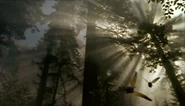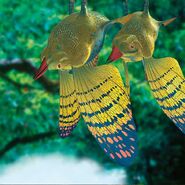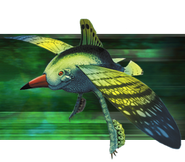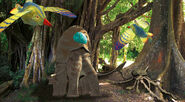| Forest flish Temporal range: 200 million AD | |
|---|---|
| Scientific classification | |
| Kingdom: | Animalia |
| Phylum: | Chordata |
| Class: | Actinopterygii |
| Gallery | |
| “ | In the gloom of the tangled branches and trailing curtains of the lichen trees, bright little jewels flit about. They are as brightly coloured as butterflies, but they dart like wrens and hum like humming birds.
|
” |
The forest flish is a species of small, insectivorous flish native to the Northern Forest of Pangaea II in 200 million AD. It is the smallest species of flish in the Northern Forest.[1]
Evolution[]
- See also: Flish#Evolution.
More specialised cousins of ocean flish, the forest flish has evolved the capacity to abandon the sea altogether, instead being highly adapted to a rainforest environment. Like the ocean flish, its fins have evolved into wings. The posterior fins have become hook-like feet which enable the flish to roost.
The forest flish evolved to take the place of forest birds like hummingbirds, which were all wiped out by the 100 million AD mass extinction.
The gill of the forest flish has evolved into several parts. Part of the exterior gill has become an ear, whilst the gill arches in the throat are now capable of producing sound. The rest of the gill has evolved into a membrane to amplify the chirping created by the arches.[2]
Biology[]

A forest flish in flight.
The green-and-blue scaled forest flish is smaller, more compact, and more lightly built than its maritime cousin. Its pectoral wings are smaller, similar in structure to those of a butterfly, and are capable of flapping far faster, up to 30 beats a second. The forest flish's pelvic fins have evolved into small hooks, enabling them to roost from the branches of trees.
Behaviour[]
With wings capable of beating up to thirty times per second, the forest flish is agile enough to hover in the air and catch the small flying insects populating the lichen forest. It tends to travel and roost in small groups. The forest flish communicates by making chirping noises using the gill arches in its throat. Its call more closely resembles the shrill grating of a grasshopper than the fluid notes of a bird. Like bats, they roost upside down, hanging from branches.
Ecology[]
The forest flish occupies the niche of a common insectivorous forest bird, such as a hummingbird. The flish sometimes uses lichen trees for roosting. The slithersucker relies on the flish for food, and in turn the lichen tree relies on it for fertilisation. Squibbons are agile enough to occasionally catch and eat forest flish.
Appearances[]
In the documentary[]
In "The Tentacled Forest", a flock of forest flish return home for the night to roost. However, one flish gets caught up in a slithersucker, and is digested. More flish appear in the background later on, being chased by baby squibbons.
In the manga[]
In "Northern Forest," flish are chased through the canopy by young squibbons.
In the cartoon series[]
Major appearances[]
In "Sweet Home Pangaea II," the Time Flyer crew tries to teach Squibbon how to survive in the wild, starting with catching flish. Squibby is initially disgusted by the idea of eating something alive, and also turns out to be a hopeless flish-catcher. When he escapes, caged flish are used to lure him back.
In "Cure For The Common Megasquid Cold," Squibby once again escapes, and rescues a forest flish named Flare from being eaten by a slithersucker. He takes Flare back to the Time Flyer and feeds him flies, but the flish is found and released by Emily. Flare quickly tells his friends about his experience and leads them back to the Time Flyer, resulting in the whole flock infesting the ship, until Emily and Luis manage to get them all out. In the end, Squibby again feeds flies to both Flare and another flish.
Minor appearances[]
A flock of forest flish make a brief cameo in "He Might Be Giant," travelling through the forest.
List of appearances[]
- The Future is Wild
- 1x01. Welcome to the Future
- 1x13. The Tentacled Forest
- The Future Is Wild: A Natural History of the Future
- The Future is Wild manga
- 08. Northern Forest
- The Future Is Wild animated series
- 1x14. Sweet Home Pangaea II
- 1x21. He Might Be Giant
- 1x23. Cure For the Common Megasquid Cold
- The Future Is Wild: The Living Book
Behind the scenes[]
Criticism[]
Gallery[]
In other languages[]
| Language | Name | Translation |
|---|---|---|
| French | Oisson des forêts | Same as English name (see also flish#In other languages) |
| German | Waldflisch | Same as English name |
| Japanese | Foresutofurisshu (フォレストフリッシュ) | Transcription of English name |
| Czech | rybták lesní | Same as English name |
References[]
- ↑ Dixon, Dougal & Adams, Joanna (2014) The Future Is Wild: The Living Book
- ↑ The Future Is Wild: A Natural History of the Future
[]
| |||||||||||












